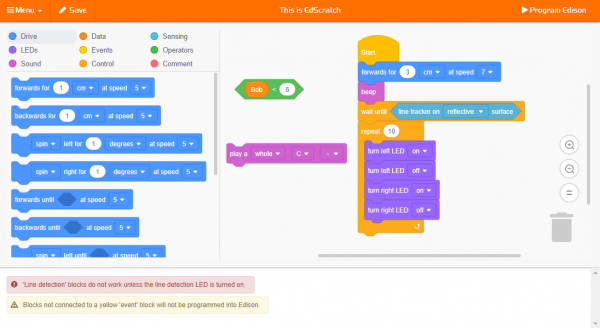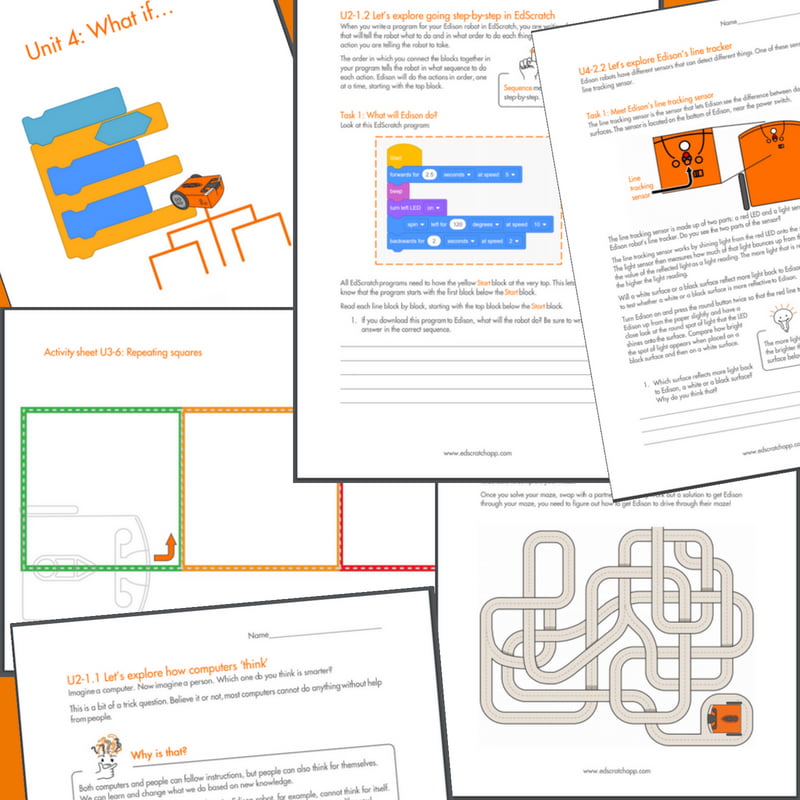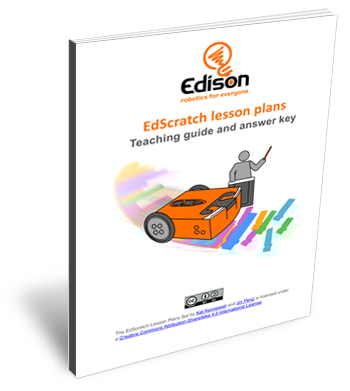EdScratch programming language
EdScratch is a vertical block-based visual programming language based on Scratch. EdScratch combines the ease of drag-and-drop programming with powerful functionality and versatility. The result is a robot programming language that is easy to learn and offers a robust platform for computer science education.
The online EdScratch programming environment is designed to deliver meaningful computer science education through an easy-to-use interface. EdScratch’s intuitive layout and the simplicity of block-based coding makes EdScratch an ideal programming language for students aged 10 and up. Helpful features, like the built-in bug box, make the transition to using more complex programming structures approachable even with no prior coding experience. As students gain confidence in coding, they can do even more by controlling inputs, manipulating data, and creating and utilising variables, making EdScratch a perfect platform to use Edison’s features in engaging, creative ways.
You can access EdScratch online at www.edscratchapp.com
To help you get the most out of EdScratch, we’ve also created a series of free video tutorials organized around the units in our free EdScratch lesson plans. Each tutorial video in the series examines new elements in the EdScratch environment and the related computer science concepts from the lessons.
Resources
These free, downloadable resources can help you get the most out of EdScratch.
The EdScratch lesson plans set
Consisting of the Student Set and accompanying Teacher’s Guide, The EdScratch Lesson Plans Set includes a complete curriculum for teaching computational thinking and computer science using EdScratch and the Edison robot. The lesson activities and project ideas are organised into six units beginning with an initial preparatory unit and culminating in an open-ended project-based unit. Designed for flexible use, you can choose just the activities that suit your interests or teach the entire curriculum!
Lesson activities – student set
The student set of the EdScratch lesson activities contains worksheets and activity sheets designed for independent use by students in Year 5 (10-11 years old) and above. With 98 activity options organized into six units, the student set contains a mix of structured and open-ended activities that introduce key concepts and learning objectives while engaging students in an active exploration of Edison and EdScratch.
The student lessons include clear instructions, colourful illustrations, activity sheets for testing program solutions and challenges for students to work through as they learn computational thinking and computer science fundamentals.
Download the EdScratch lesson activities – complete student set
Teacher’s guide to EdScratch
This guide offers teachers and instructors overviews, delivery recommendations and other supporting information for the EdScratch lesson activities to help make teaching EdScratch easy and fun. Designed to be used in partnership with the EdScratch student set, the teaching guide provides:
- an overview of each unit, including the key learning objectives of that unit,
- an overview of each lesson with a list of all activities in that lesson,
- a dedicated section per activity detailing:
- the activity’s purpose and objectives,
- supporting information including estimated time requirements, supply requirements, and tips for delivery, and
- an answer key including recommendations on assessing student work.
EdScratch warning messages guide
The EdScratch programming environment includes a ‘bug box’ at the bottom of the app which automatically checks for errors in the program. Warning messages are displayed in this bug box to help you find and fix problems in your code.
This guide includes all the warning messages that can be displayed in the bug box of the EdScratch language app, including an explanation of what each means and examples of when you may encounter the message.
FAQ
How do I access EdScratch?
EdScratch is available online at https://www.edscratchapp.com/
How do I download a program to Edison?
To download a program to Edison, first connect Edison to your computer or tablet via the EdComm cable. Make sure that the volume on your device is at maximum and all sound enhancements are disabled. Press the round p on Edison one time. Then click on the ‘program Edison’ p in the top-right corner of the app. A new window will pop-up. Follow the instructions on the window and click ‘program Edison’ on the new window. The program will then download into Edison. Remember to listen for the success sound before unplugging the EdComm cable to ensure the program fully downloads.
How do I run an EdScratch program on Edison?
Once you have successfully downloaded a program to Edison, disconnect the EdComm cable from Edison. To run the program on Edison, press the play (triangle) p on Edison one time. This will immediately start your program.
The Edison robot will then carry out the program’s commands in sequential order, moving through the code step-by-step.
Where do I find all the blocks I can use?
All of the EdScratch blocks are in the block pallet, which is located on the left-hand side of the EdScratch programming environment. Select a category from the nine options at the top of the block pallet to see all the blocks inside that category.
How do I know what a block does?
The written description on each EdScratch block describes the command that block gives to the program. For any blocks which have input parameters, (including number inputs, drop-down menu options and greyed-out holes) you can change the input parameters to modify the command.
You can learn more about the different EdScratch blocks in our tutorial videos which walk through each type of block in line with the EdScratch lesson plans.
What are the greyed-out holes in some of the blocks?
Some EdScratch blocks contain an oval or a diamond-shaped hole which is greyed-out in the base block. These holes are spots for special input parameters which can be added to the block using appropriate diamond or oval-shaped input blocks.
Helpful warning messages related to these blocks will appear in the bug box at the bottom of the EdScratch programming environment. These messages provide details specific to the blocks in your program.
You can learn more about these types of input parameters in our tutorial videos which walk through each type of input parameter in line with the EdScratch lesson plans.
What are the yellow and red messages in EdScratch?
The EdScratch programming environment includes a ‘bug box’ at the bottom of the app which automatically checks for errors in the program. Warning messages are displayed in this bug box to help you find and fix problems in your code. There are both red and yellow warning messages which can appear depending on the issue detected.
You can learn more about the error messages in EdScratch in our tutorial videos and in the EdScratch warning messages guide.
How do I save my EdScratch program?
To save a program you make in EdScratch to your computer, go into ‘Menu’ and select the ‘Save to Computer’ option. A pop-up box will open where you will give your program a name. Once you have named your program, click the ‘Save to Computer’ p. Your program will then be downloaded as a file to your computer.
Note: make sure your browser allows pop-ups for www.edscratchapp.com since the programming environment uses a pop-up for naming your save file.
How do I load an EdScratch program?
To upload a saved file from your computer into EdScratch, open the EdScratch online application, go into ‘Menu’ and select the ‘Load from Computer’ option. A pop-up box will open. Follow the steps and select the EdScratch save file you want to load from your computer. (All EdScratch save files are file type .ees.) Once you have selected your file, click the ‘Load program’ p to upload and run the program in EdScratch.
Note: make sure your browser allows pop-ups for www.edscratchapp.com since the programming environment uses a pop-up for choosing which files you want to upload.
How do I delete blocks?
Blocks can be deleted by dragging them to the bin in the lower right-hand corner of the EdScratch app, dragging the blocks back to the block pallet, or by right clicking the block with your mouse and choosing the ‘Delete Block’ option.
How do I copy blocks?
You can add additional copies of blocks to the programming space by dragging the blocks you want from the block pallet to the programming area. You can also right click the block with your mouse and choose the ‘Duplicate’ option.
Blocks in the ‘Events’ category of the block pallet cannot be duplicated. A maximum of one of each Event category blocks can be in a program. You can learn more about the Event category blocks in our tutorial videos and the EdScratch lesson plans.
Where are the blocks in the ‘Data’ category?
The Data category allows you to make and manage variables for use in your EdScratch programs. To use variables in EdScratch, click on the Data category in the block pallet, then click on the ‘Make a variable’ p. Once you enter a name for your variable, click the ‘Create Variable’ p. This will generate your variable and populate the Data category with a set of blocks you can use with any variables in your program.
You can learn more about the Data category and variables in the Unit 5 video of our tutorial videos and in the same unit inside the EdScratch lesson plans.
What characters can I use in my variable names in EdScratch?
EdScratch variable names can only contain lowercase English letters, uppercase English letters, numbers, and underscores ( _ ). Other symbols, like exclamation marks ( ! ) or spaces, are not allowed. Variable names cannot start with a number.
About EdScratch
What kind of language is EdScratch?
EdScratch is a vertical drag-and-drop block-based system that has been developed using the Scratch Blocks code base developed by the MIT Media Lab from the Blockly code base developed by Google.
EdScratch is developed by Microbric Pty Ltd using open source software created and maintained by the Scratch Foundation. The Scratch Foundation does not sponsor, endorse, or authorize this content. See scratch.mit.edu for more information.
What age user is EdScratch for?
EdScratch combines the ease of drag-and-drop programming with powerful functionality and flexibility, making it an ideal language for learning the foundations of computer science. EdScratch and the free-to-download EdScratch lessons are ideal for students in Year 5 (10-11 years old) and above.
What do the different categories of blocks in EdScratch do?
All of the blocks in EdScratch are arranged into one of the nine different block categories in the block pallet.
Drive
The dark blue blocks in the Drive category are all related to the Edison robot’s motor outputs.
LEDs
The dark purple blocks in the LEDs category are all related to the Edison robot’s LED outputs. Both the visible light (red LEDs) and infrared LEDs outputs (for IR messaging) can be controlled using blocks in this category.
Sound
The light purple blocks in the Sound category are all related to the Edison robot’s audio outputs. Single beeps, musical notes and blocks which control only music note blocks are all in this category.
Data
Initially containing only two ps, the Data category is how you make and manage variables in EdScratch. Once a variable has been created by using the ‘Make a variable’ p and giving the variable a name, the Data category is populated with dark orange blocks related to data manipulation using any created variables.
Events
The yellow blocks in the Event category are all sensor-related event blocks that can be used as interrupts beginning subroutines in EdScratch programs.
Control
The light orange blocks in the Control category are all programming control structures which can be used to affect the flow of an EdScratch program. Loops, waits and if-statement control blocks can all be found in the Control category.
Sensing
The light blue blocks in the Sensing category are all related to the Edison robot’s various sensors. These blocks allow you to turn different sensors on or off, clear stored sensing data and use sensing data as value inputs (oval shaped blocks) or Boolean inputs (diamond-shaped blocks) inside blocks in an EdScratch program.
Operators
The green blocks in the Operators category are all blocks that can be used as either value inputs (oval shaped blocks) or Boolean inputs (diamond-shaped blocks) inside blocks in an EdScratch program. The Operators category blocks include expressions and computation operators designed to be used with sensing and other data inside programs.
Comment
The pink block in the Comment category allows you to add in text comments as notes in a program. Comment blocks are ignored by the compiler and have no affect on the EdScratch program. Comments are designed to be used as useful ‘sticky-notes’ helping the programmer and others understand the program.
Which browsers are compatible with EdScratch?
EdScratch is compatible with Chrome, Safari, Microsoft Edge and Firefox. To ensure optimal performance, it is strongly recommended that you use EdScratch with Chrome.
Is there an EdScratch iOS/Android app?
You can use EdScratch through the online app at https://www.edscratchapp.com/ with devices running either iOS or Android. Dedicated iOS and Android apps for EdScratch are being considered but are not currently in development. Please be sure to sign up to our newsletter to be informed about future app releases.
Is there an offline version of EdScratch?
At this time, there is no offline or downloadable version of EdScratch in development. As such, you do require an internet connection to use EdScratch.
EdScratch requires the code you program in the environment to be compiled in order to be downloaded into the Edison robot. To ensure the compiler works correctly across all platforms and keep costs such that we can deliver EdScratch at no charge, delivering through an online solution is the best option for EdScratch. This online solution also enables us to ensure that we are able to provide updates and improvements into the live system for all users on an ongoing basis.
What kind of language is EdScratch?
EdScratch is a vertical drag-and-drop block-based system that has been developed using the Scratch Blocks code base developed by the MIT Media Lab from the Blockly code base developed by Google.
EdScratch is developed by Microbric Pty Ltd using open source software created and maintained by the Scratch Foundation. The Scratch Foundation does not sponsor, endorse, or authorize this content. See scratch.mit.edu for more information.
Videos
Let's Explore EdScratch
EdScratch: Overview
EdScratch: Tutorial for unit 1
EdScratch: Tutorial for unit 2
EdScratch: Tutorial for unit 3
EdScratch: Tutorial for unit 4
EdScratch: Tutorial for unit 5
EdScratch tutorials
Additional resources
Translation kits, translated versions and more.
- Example code for the barcode programs in EdScratch
Licenced under Creative Commons – use, adapt and share
We want to make robotics and computer science education available to everyone, which is why these teaching resources have been released under a Creative Commons licence. You are free to use these resources as they are, translate them, share them or use them as the base to develop your own customised lessons.

The EdScratch Lesson Plans Set by Kat Kennewell and Jin Peng is licensed under a Creative Commons Attribution-ShareAlike 4.0 International License.
You are free to:
Share — copy and redistribute the material in any medium or format
Adapt — remix, transform, and build upon the material for any purpose, even commercially.
Attribution — You must give appropriate credit, provide a link to the license, and indicate if changes were made. You may do so in any reasonable manner, but not in any way that suggests the licensor endorses you or your use.
ShareAlike — If you remix, transform, or build upon the material, you must distribute your contributions under the same license as the original.
EdScratch resources translation kit
Looking to translate the EdScratch resources into another language? Download the translation kit to get the editable files you will need.
Translated EdScratch educational resources
Download In-app EdScratch blocks French translations (French by Jonathan Barette)



